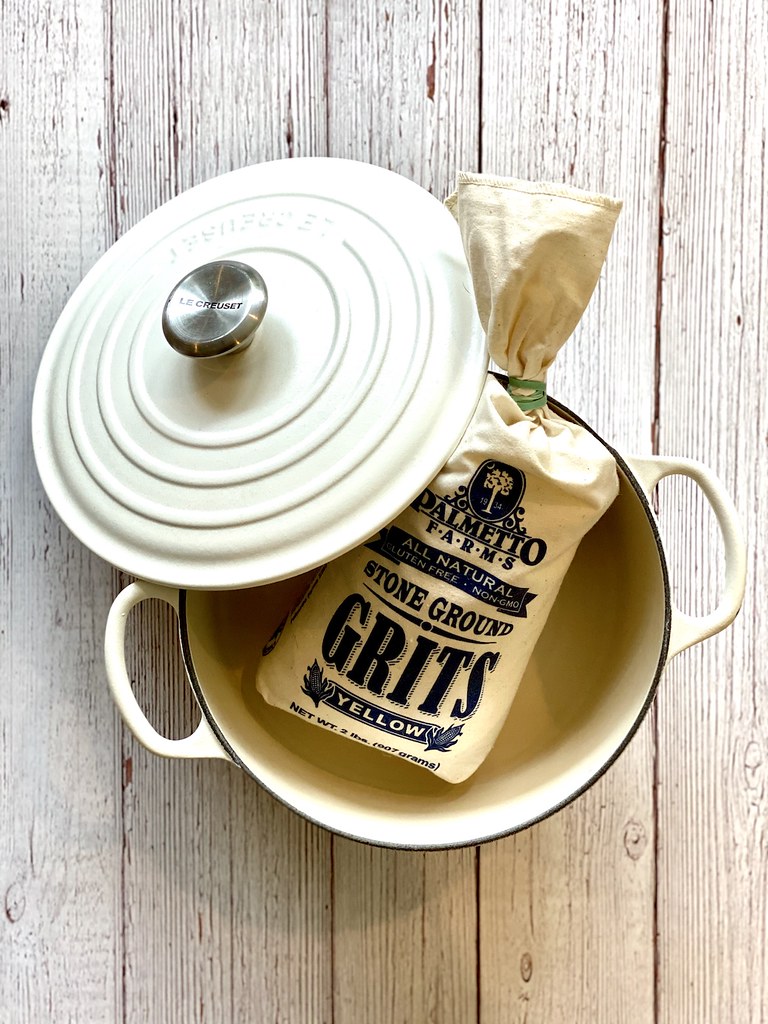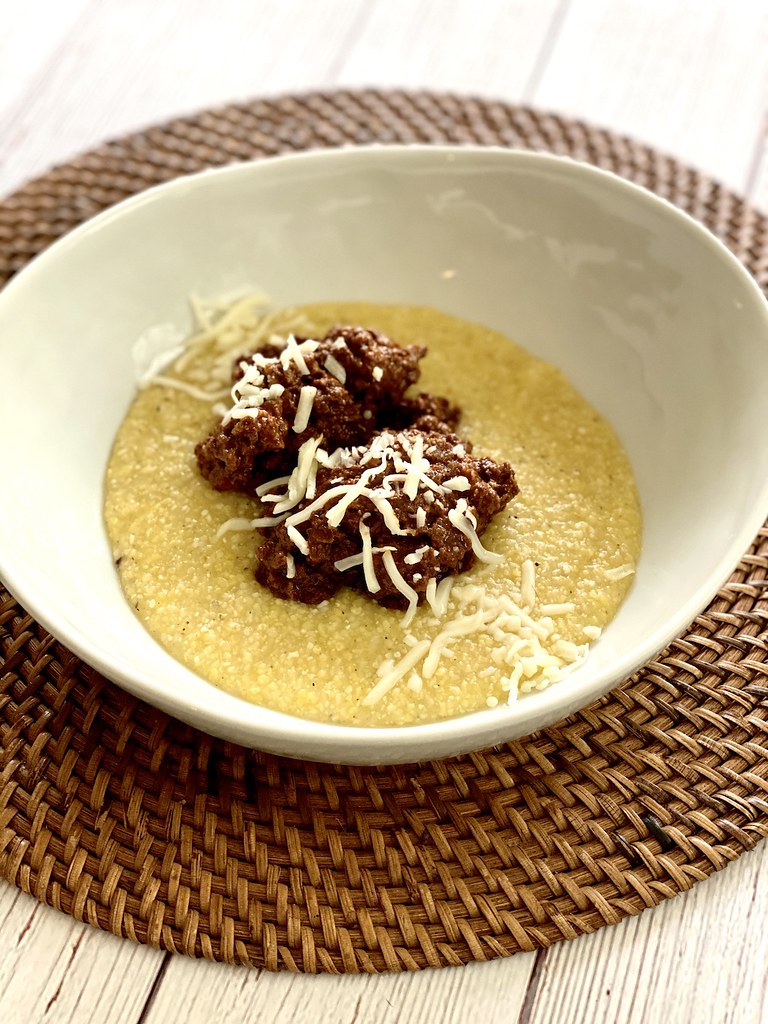On more than one occasion, I have heard individuals claim that they “don’t like grits,” and can’t understand why we do. That’s all fine and dandy… IF they have tried the real deal! To each their own, right? But, more often than not, those individuals have tried the instant, overly processed, and flavorless versions. That, my friends, is a crying shame that I hope to fix. So, let me teach you about southern style grits!
My first piece of advice when buying grits: do not let the “quick” or “instant” versions of our regionally southern dish fool you. Though these words scream *ease* and *convenience*, you will be disappointed with the outcome.
My reasoning behind this: It takes a long time to rehydrate this corn based product. The “quick” 5-minute versions do partially rehydrate, but not to the fullest extent. You will have bites that remain a bit grainy and/or crunchy. True stone-ground grits can take from 45 minutes to 1½ hours to cook. A huge time difference! Like many things in the south, there is nothing “quick” about properly made grits.
Instead, bite into a good locally sourced bowl of stone-ground hominy. I know…I know…most of you reading this 1) are not from or currently in the south, 2) are not located near a miller, or 3) don’t even know where to start shopping outside of your normal grocery store. This is even more true during these COVID-19 times. I hear you. Having relocated further north and in self-isolation, I can check off all three boxes myself. Instead, I will give you a list of great stone-ground southern style grits you can order from the internet and sometimes find in specialty stores. Let’s dive into learning about grits.
A Brief History of Southern Style Grits:
Grits have been a staple in the Southern diet for centuries. Though this is the case, many southerners have no idea about the history of their regional dish. It is important to know where grits came from: grits did NOT come from and were not invented by the white settlers. In fact, the Native Americans introduced grits to settlers in the 16th century.
Before settlers arrived in the Americas, the Native Americans already had a long history of growing, cultivating, and cooking maize–otherwise known as corn. They had already developed a version of creamy, softly mashed corn.
We know that in 1584, Sir Walter Raleigh and his men shared a meal with local Native Americans during a surveillance of the lands that would become present-day North Carolina. One of his men, Arthur Barlowe, wrote about a “very white, faire, and well tasted” dish made of boiled corn.
This staple meal–called “Rockahomine” by the Natives, and renamed “hominy” by the colonists–was introduced to new settlers in Jamestown, Virginia in 1607. It was at this time that the Native Americans taught the colonists how to make the dish, which quickly became part of the southern American diet. So, for those eating grits, you are eating a traditional Native American meal and one of the earliest introduced dishes to the settlers in the Americas.
Over time, grits became a tradition in nearly every southern state, but especially so in the “Lowcountry,” otherwise known as coastal South Carolina and Georgia. It is here where you will come across the normal breakfast grits, the famous shrimp and grits, and countless other grit varieties.

Where to Buy Stone-Ground Southern Style Grits:
Below is a list of some of my favorite companies. If you know of others that make amazing stone-ground grits, let us know in the comment section down below!
1. Palmetto Farms
- Palmetto Farms in located in Galivants Ferry, South Carolina.
- Allergen free. Made in a gluten and allergen-free facility. My personal favorite as I am gluten-free.
2. Anson Mills
- Anson Mills is located in Columbia, South Carolina.
- The company produces a lot of different products. They list which items are gluten and allergen-free on their website.
3. Geechie Boy Market and Mill
- Geechie Boy Market and Mill is located on Edisto Island, South Carolina
- Their Grits are processed on machinery that also processes other allergens. For those without an allergy and only a sensitivity, these are a good choice.
4. Bob’s Red Mill
Milwaukie, Oregon
- Bob’s Red Mill headquarters are located in Milwaukie, Oregon.
- The company lists all allergens associated with their products. The grits are gluten and allergen-free.
What is the Difference Between Polenta and Southern Style Grits?
Many people get confused about the difference between grits and polenta. Grits are an integral part of the southern diet, while Polenta comes from across the ocean in Italy. Grits and Polenta are both corn-based products. So, what exactly is the difference? The two key differences are: 1) the type and processing of the corn, and 2) the locals’ definition of the dish.
The Type and Processing of Corn:
Polenta’s yellow color comes from the type of corn—Floriani Red Flint is a rare heirloom corn grown in Italy.
Traditionally, Alpine farmers carefully cultivate the corn, thus allowing the sweet, savory, and rich flavors to develop. Floriani Red Flint contains a hard starchy center. The starch from the “flint” corn provides the polenta’s granular and gritty texture, even when processed and cooked.
The processing of corn into polenta simply consists of drying and coarsely grinding the corn kernels.
Grits, on the other hand, can be made from different types of corn. Most commonly, grits are made from coarsely ground white corn. The processing often starts with treating corn with lime or another alkaline to remove the hull, thus becoming hominy. Corn used to make grits is often known as “dent”–named for the indentation developed on the kernels after it has dried. Unlike polenta, the varieties of corn used have soft starch, allowing grits to be smooth and creamy, and have little structure.
All-in-all, the main difference is texture!
How Locals Define the Dish:
Unlike grits, the word “polenta” refers to the actual dish, not the ingredient. Polenta can be a corn product or a porridge made with different types of rice, beans, or other grains. The corn-based version just happens to be the most famous outside of Italy.
Southern style grits are defined by the ingredient. Grits MUST be corn and it MUST be ground. How the dish is served is entirely in the preference of the chef preparing the meal.

Are Grits Allergen-Free and Gluten-free?
Grits are naturally free of the top allergens such as gluten, milk, eggs, fish, shellfish, tree nuts, peanuts, and soy. However, we should talk about cross-contamination. Cross-contamination is the process by which bacteria or other microorganisms are unintentionally transferred from one object to another. This happens often in the food industry.
Often, corn-based products are produced and packaged on machinery that also produces wheat and other allergen-based products. It is at this point when cross-contamination usually occurs. When buying grits, always check the allergy information, because a lot of brands ARE NOT allergen free.
Grits are naturally gluten and allergen-free. Though this is the case, there is often cross-contamination. Always check allergy information.
Are Grits Vegan and Vegetarian?
Grits are naturally both vegan and vegetarian on its own. However, the preparation can cause the dish to not be vegan or vegetarian.
When eating out, especially in southern restaurants, always ask the server if there is any milk, heavy cream, butter, or stock in the grits. More often than not, grits are started with water and/or stock and finished with a heavy dose of milk, heavy cream, and butter. I have yet to meet a southern chef who does it differently, unless he or she is paying attention to the ingredients for a particular customer.
It will always be a bit easier for vegetarians. You will sometimes find that no stock is used for the grits, as chefs often use salted water.
For you vegans out there, I am sorry, but it will be hard to find a chef that doesn’t use a dairy product.
Remember: ALWAYS ASK. Though naturally vegan and vegetarian, it is not always that way in a restaurant.
Quick Tips for Cooking Southern Style Grits:

1. Pre-Soak Your Grits
The professionals pre-soak their grits. Grits soaked overnight cook faster, more evenly, and are softer and creamier. If you choose you soak overnight, remove the floating sedatives and grains before cooking. You can do a quick soak for 20 minutes to an hour if you decide you want grits the day-of.
If you decide in the morning that you want grits and can’t wait, just skip the pre-soaking step. I do this all the time. It won’t be as creamy, but I’m willing to sacrifice the texture when I get a craving for a taste from my childhood — Saturday morning grits, bacon, and eggs with the family. My Dad had a pot going before I even woke, and shouted “BRRRRREAKFAST” from the bottom of the stairs to get my sister and I out of bed.
2. Whisk
Do not dump your grits into the boiling pot of water! WHISK! Whisk the grits into water to avoid clumping.
3. Finish Your Southern Style Grits Right
Some people say to cook grits with milk. I disagree. I always cook with salted water or chicken stock and finish with cream and butter. If you are cooking with milk and not paying attention, the milk will be burning on the bottom of your pot! Adding it in the end still gives that creamy and smooth texture.
Southerners almost always add cheese to their grits. If adding cheese, I prefer a bit of goat and some cheddar! Pick your cheese based on your preference.
Voila! There you have it: your guide to basic southern grits. Remember, what makes good grits is quality and freshness. If you bought grits but will not eat the bag quickly, stick some in the freezer. It preserves the freshness!
If you really want to try making a true southern breakfast, try cooking your eggs and bacon in a cast-iron skillet. You can find a guide to caring for your cast-iron skillet on our blog!

Do you like them more thick or watery? Do you like finishing your grits with cream, butter, and cheese? Let us know how you prefer to eat your grits in the comments below. I personally love to eat my grits with a cup of coffee. I use my leftover grits and polenta to make cakes to serve underneath smoked salmon.
If eating for the first time, let us know what you think of our creamy, southern style grits! You can follow us at @carvingajourney on Instagram, Twitter, Facebook, and Pinterest.
Carving A Journey is a participant in the Amazon Services LLC Associates Program, an affiliate advertising program designed to provide a means for sites to earn advertising fees by advertising and linking to Amazon.com. Although we may earn commissions for our endorsement, recommendation, testimonial, and/or link to any products or services from this website, these opinions are my own and I fully support these products.


